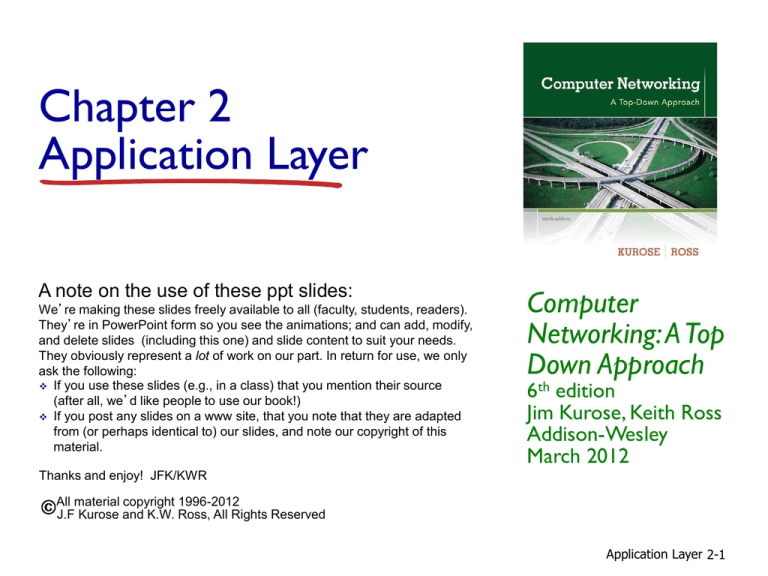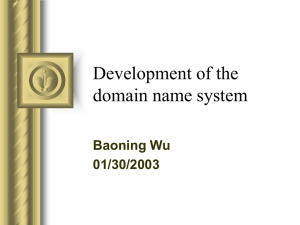
Chapter 2
Application Layer
A note on the use of these ppt slides:
We’re making these slides freely available to all (faculty, students, readers).
They’re in PowerPoint form so you see the animations; and can add, modify,
and delete slides (including this one) and slide content to suit your needs.
They obviously represent a lot of work on our part. In return for use, we only
ask the following:
If you use these slides (e.g., in a class) that you mention their source
(after all, we’d like people to use our book!)
If you post any slides on a www site, that you note that they are adapted
from (or perhaps identical to) our slides, and note our copyright of this
material.
Computer
Networking: A Top
Down Approach
6th edition
Jim Kurose, Keith Ross
Addison-Wesley
March 2012
Thanks and enjoy! JFK/KWR
All material copyright 1996-2012
J.F Kurose and K.W. Ross, All Rights Reserved
Application Layer 2-1
Chapter 2: outline
2.1 principles of network
applications
app architectures
app requirements
2.6 P2P applications
2.7 socket programming
with UDP and TCP
2.2 Web and HTTP
2.3 FTP
2.4 electronic mail
SMTP, POP3, IMAP
2.5 DNS
Application Layer 2-2
DNS: domain name system
people: many identifiers:
SSN, name, passport #
Internet hosts, routers:
IP address (32 bit) used for addressing
datagrams
“name”, e.g.,
www.yahoo.com used by humans
Q: how to map between IP
address and name, and
vice versa ?
Domain Name System:
distributed database
implemented in hierarchy of
many name servers
application-layer protocol: hosts,
name servers communicate to
resolve names (address/name
translation)
note: core Internet function,
implemented as applicationlayer protocol
complexity at network’s
“edge”
Application Layer 2-3
DNS: services, structure
DNS services
hostname to IP address
translation
host aliasing
canonical, alias names
mail server aliasing
load distribution
replicated Web
servers: many IP
addresses correspond
to one name
why not centralize DNS?
single point of failure
traffic volume
distant centralized database
maintenance
A: doesn’t scale!
Application Layer 2-4
DNS: a distributed, hierarchical database
Root DNS Servers
…
com DNS servers
yahoo.com
amazon.com
DNS servers DNS servers
…
org DNS servers
pbs.org
DNS servers
edu DNS servers
poly.edu
umass.edu
DNS serversDNS servers
client wants IP for www.amazon.com; 1st approx:
client queries root server to find com DNS server
client queries .com DNS server to get amazon.com DNS server
client queries amazon.com DNS server to get IP address for
www.amazon.com
Application Layer 2-5
DNS: root name servers
contacted by local name server that can not resolve name
root name server:
contacts authoritative name server if name mapping not known
gets mapping
returns mapping to local name server
c. Cogent, Herndon, VA (5 other sites)
d. U Maryland College Park, MD
h. ARL Aberdeen, MD
j. Verisign, Dulles VA (69 other sites )
e. NASA Mt View, CA
f. Internet Software C.
Palo Alto, CA (and 48 other
sites)
a. Verisign, Los Angeles CA
(5 other sites)
b. USC-ISI Marina del Rey, CA
l. ICANN Los Angeles, CA
(41 other sites)
g. US DoD Columbus,
OH (5 other sites)
k. RIPE London (17 other sites)
i. Netnod, Stockholm (37 other sites)
m. WIDE Tokyo
(5 other sites)
13 root name
“servers”
worldwide
Application Layer 2-6
TLD, authoritative servers
top-level domain (TLD) servers:
responsible for com, org, net, edu, aero, jobs, museums,
and all top-level country domains, e.g.: uk, fr, ca, jp
Network Solutions maintains servers for .com TLD
Educause for .edu TLD
authoritative DNS servers:
organization’s own DNS server(s), providing
authoritative hostname to IP mappings for organization’s
named hosts
can be maintained by organization or service provider
Application Layer 2-7
Local DNS name server
does not strictly belong to hierarchy
each ISP (residential ISP, company, university) has
one
also called “default name server”
when host makes DNS query, query is sent to its
local DNS server
has local cache of recent name-to-address translation
pairs (but may be out of date!)
acts as proxy, forwards query into hierarchy
Application Layer 2-8
DNS name
resolution example
root DNS server
2
host at cis.poly.edu
wants IP address for
gaia.cs.umass.edu
iterated query:
contacted server
replies with name of
server to contact
“I don’t know this
name, but ask this
server”
3
TLD DNS server
4
5
local DNS server
dns.poly.edu
1
8
7
6
authoritative DNS server
dns.cs.umass.edu
requesting host
cis.poly.edu
gaia.cs.umass.edu
Application Layer 2-9
DNS name
resolution example
root DNS server
recursive query:
puts burden of name
resolution on
contacted name
server
heavy load at upper
levels of hierarchy?
3
2
7
6
TLD DNS
server
local DNS server
dns.poly.edu
1
5
4
8
authoritative DNS server
dns.cs.umass.edu
requesting host
cis.poly.edu
gaia.cs.umass.edu
Application Layer 2-10
DNS: caching, updating records
once (any) name server learns mapping, it caches
mapping
cache entries timeout (disappear) after some time (TTL)
TLD servers typically cached in local name servers
• thus root name servers not often visited
cached entries may be out-of-date (best effort
name-to-address translation!)
if name host changes IP address, may not be known
Internet-wide until all TTLs expire
update/notify mechanisms proposed IETF standard
RFC 2136
Application Layer 2-11
DNS records
DNS: distributed db storing resource records (RR)
RR format: (name,
type=A
name is hostname
value is IP address
type=NS
name is domain (e.g.,
foo.com)
value is hostname of
authoritative name
server for this domain
value, type, ttl)
type=CNAME
name is alias name for some
“canonical” (the real) name
www.ibm.com is really
servereast.backup2.ibm.com
value is canonical name
type=MX
value is name of mailserver
associated with name
Application Layer 2-12
DNS protocol, messages
query and reply messages, both with same message
format
2 bytes
2 bytes
msg header
identification: 16 bit # for
query, reply to query uses
same #
flags:
query or reply
recursion desired
recursion available
reply is authoritative
identification
flags
# questions
# answer RRs
# authority RRs
# additional RRs
questions (variable # of questions)
answers (variable # of RRs)
authority (variable # of RRs)
additional info (variable # of RRs)
Application Layer 2-13
DNS protocol, messages
2 bytes
2 bytes
identification
flags
# questions
# answer RRs
# authority RRs
# additional RRs
name, type fields
for a query
questions (variable # of questions)
RRs in response
to query
answers (variable # of RRs)
records for
authoritative servers
authority (variable # of RRs)
additional “helpful”
info that may be used
additional info (variable # of RRs)
Application Layer 2-14
Inserting records into DNS
example: new startup “Network Utopia”
register name networkuptopia.com at DNS registrar
(e.g., Network Solutions)
provide names, IP addresses of authoritative name server
(primary and secondary)
registrar inserts two RRs into .com TLD server:
(networkutopia.com, dns1.networkutopia.com, NS)
(dns1.networkutopia.com, 212.212.212.1, A)
create authoritative server type A record for
www.networkuptopia.com; type MX record for
networkutopia.com
Application Layer 2-15
Attacking DNS
DDoS attacks
Bombard root servers
with traffic
Not successful to date
Traffic Filtering
Local DNS servers
cache IPs of TLD
servers, allowing root
server bypass
Bombard TLD servers
Potentially more
dangerous
Redirect attacks
Man-in-middle
Intercept queries
DNS poisoning
Send bogus relies to
DNS server, which
caches
Exploit DNS for DDoS
Send queries with
spoofed source
address: target IP
Requires amplification
Application Layer 2-16
Chapter 2: outline
2.1 principles of network
applications
app architectures
app requirements
2.6 P2P applications
2.7 socket programming
with UDP and TCP
2.2 Web and HTTP
2.3 FTP
2.4 electronic mail
SMTP, POP3, IMAP
2.5 DNS
Application Layer 2-17
Pure P2P architecture
no always-on server
arbitrary end systems
directly communicate
peers are intermittently
connected and change IP
addresses
examples:
file distribution
(BitTorrent)
Streaming (KanKan)
VoIP (Skype)
Application Layer 2-18
Chapter 2: summary
our study of network apps now complete!
application architectures
client-server
P2P
application service
requirements:
reliability, bandwidth, delay
Internet transport service
model
connection-oriented,
reliable: TCP
unreliable, datagrams: UDP
specific protocols:
HTTP
FTP
SMTP, POP, IMAP
DNS
P2P: BitTorrent, DHT
socket programming: TCP,
UDP sockets
Application Layer 2-19
Chapter 2: summary
most importantly: learned about protocols!
typical request/reply
message exchange:
client requests info or
service
server responds with
data, status code
message formats:
headers: fields giving
info about data
data: info being
communicated
important themes:
control vs. data msgs
in-band, out-of-band
centralized vs. decentralized
stateless vs. stateful
reliable vs. unreliable msg
transfer
“complexity at network
edge”
Application Layer 2-20






